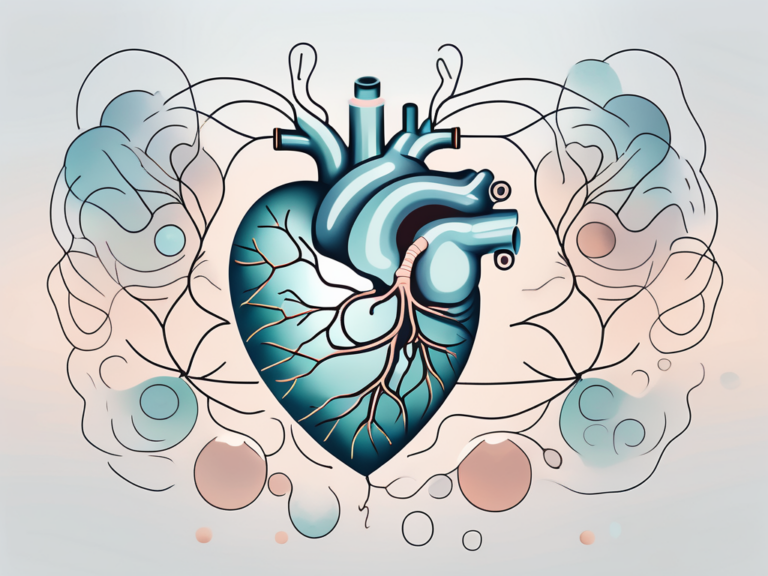meditation vagus nerve stimulation
Meditation is a practice that has gained considerable popularity in recent years for its numerous health benefits. One particular area of interest is the connection between meditation and vagus nerve stimulation. The vagus nerve, also known as the “wandering nerve,” plays a crucial role in the body, particularly in regulating various bodily functions and maintaining overall well-being.
Understanding the Vagus Nerve
The vagus nerve is one of the longest and most important nerves in the body. It originates in the brainstem and extends down to the abdomen, passing through multiple organs along the way. Its branches reach various parts of the body, including the heart, lungs, digestive system, and even the ear.
But let’s dive deeper into the intricate world of the vagus nerve and explore its fascinating role in our body.
The Role of the Vagus Nerve in the Body
The vagus nerve is responsible for regulating a wide range of bodily functions, including heart rate, digestion, breathing, and immune response. It helps to maintain a state of balance in the body, also known as homeostasis. When the vagus nerve is functioning optimally, it helps to reduce stress, promote relaxation, and improve overall well-being.
Imagine the vagus nerve as a conductor, orchestrating a symphony of bodily functions. It ensures that our heart beats at a steady rhythm, our digestive system efficiently breaks down food, and our lungs expand and contract with each breath. Without the vagus nerve’s careful guidance, our body would be like a chaotic orchestra, playing out of tune.
Connection Between the Vagus Nerve and the Brain
While the vagus nerve extends throughout the body, it also has significant connections to the brain. This bidirectional communication between the brain and the vagus nerve allows for a constant exchange of information. The vagus nerve sends signals to the brain, informing it about the body’s state and ensuring that appropriate responses are initiated. In return, the brain sends signals through the vagus nerve, influencing various bodily functions.
Think of the vagus nerve as a messenger, delivering important updates to the brain headquarters. It informs the brain about our heart rate, blood pressure, and even the state of our digestive system. This constant flow of information allows the brain to make necessary adjustments and keep our body in perfect harmony.
But the connection between the vagus nerve and the brain goes beyond simple information exchange. Studies have shown that stimulating the vagus nerve can have a profound impact on mental health. It has been used as a therapeutic technique to alleviate symptoms of depression, anxiety, and even epilepsy. This remarkable connection between the vagus nerve and our emotional well-being highlights the intricate web of connections within our body.
The Science Behind Meditation
Meditation is a practice that involves focusing one’s attention and eliminating the stream of thoughts that often occupy the mind. It has been practiced for centuries and is well-known for its ability to promote relaxation and reduce stress. In recent years, scientific research has provided insights into the physiological effects of meditation and its impact on the brain.
The Physiological Effects of Meditation
When practiced regularly, meditation has been shown to have numerous positive effects on the body. It helps to reduce stress hormone levels, lower blood pressure, and improve heart health. Additionally, meditation has been found to enhance the immune system, reduce inflammation, and promote a sense of well-being.
Let’s dive a little deeper into the physiological effects of meditation. One study conducted by researchers at Harvard Medical School found that meditation can actually change the expression of genes involved in inflammation, stress, and immune function. This means that regular meditation practice can have long-lasting effects on our overall health and well-being.
Another fascinating aspect of meditation’s impact on the body is its ability to improve sleep quality. Research has shown that individuals who meditate regularly experience better sleep, with increased sleep duration and improved sleep efficiency. This could be attributed to the relaxation response triggered by meditation, which helps to calm the mind and prepare the body for restful sleep.
Meditation and the Brain: A Deep Dive
The practice of meditation has been found to produce distinct changes in the brain. Neuroimaging studies have revealed that long-term meditation practitioners exhibit increased gray matter volume in regions associated with attention, emotional regulation, and empathy. Furthermore, meditation has been shown to enhance connectivity between different brain regions, promoting better communication and integration.
But what exactly happens in the brain during meditation? Well, research suggests that meditation activates the prefrontal cortex, which is responsible for executive functions such as attention, decision-making, and self-control. This activation leads to a heightened state of awareness and focus, allowing individuals to better regulate their emotions and thoughts.
Moreover, studies have shown that meditation can lead to an increase in the production of gamma waves in the brain. Gamma waves are associated with heightened cognitive abilities, such as improved memory, attention, and creativity. This could explain why many meditators report enhanced mental clarity and creativity after regular practice.
In conclusion, the science behind meditation is a fascinating field of study that continues to uncover the numerous benefits of this ancient practice. From its physiological effects on the body to its profound impact on the brain, meditation has proven to be a powerful tool for promoting overall well-being. So, whether you’re a seasoned meditator or just starting out, incorporating this practice into your daily routine can have profound and lasting effects on your health and happiness.
Vagus Nerve Stimulation: An Overview
In recent years, vagus nerve stimulation (VNS) has emerged as a promising technique for improving various health conditions. VNS involves the use of electrical impulses to stimulate the vagus nerve, enhancing its function and promoting overall well-being.
The vagus nerve, also known as the “wandering nerve,” is the longest cranial nerve in the body. It extends from the brainstem to the abdomen, innervating multiple organs along the way, including the heart, lungs, and digestive system. This nerve plays a crucial role in regulating various bodily functions, such as heart rate, digestion, and mood.
The Process of Vagus Nerve Stimulation
VNS is typically performed through the use of a small device that is surgically implanted in the body. This device delivers controlled electrical impulses to the vagus nerve, modulating its activity. The stimulation can be customized to address individual needs, and adjustments can be made to optimize its effects.
During the implantation procedure, the surgeon carefully places the device near the vagus nerve, ensuring precise positioning for optimal stimulation. The device is connected to a generator, which can be programmed to deliver electrical impulses at specific intervals and intensities. Patients can even control the stimulation themselves using a handheld device, allowing them to adjust the therapy according to their needs.
Benefits and Risks of Vagus Nerve Stimulation
VNS has shown promising results in the treatment of various conditions, including epilepsy, depression, and chronic pain. It has been found to reduce the frequency and severity of seizures, alleviate depressive symptoms, and provide relief from chronic pain. The exact mechanisms by which VNS exerts these therapeutic effects are still being studied, but researchers believe that it involves the modulation of neurotransmitters and the activation of various brain regions.
Despite its potential benefits, VNS also carries some risks. Common side effects include hoarseness, coughing, and shortness of breath, which are usually temporary and subside over time. In rare cases, more serious complications such as infection or vocal cord paralysis may occur. Therefore, it is crucial for individuals considering VNS to have a thorough discussion with their healthcare professional to weigh the potential benefits against the risks and make an informed decision.
The Intersection of Meditation and Vagus Nerve Stimulation
Given the link between meditation and vagus nerve stimulation, researchers are exploring the potential benefits of combining these two practices. It is believed that meditation can stimulate the vagus nerve, amplifying its effects and promoting overall well-being.
How Meditation Can Stimulate the Vagus Nerve
During meditation, the body enters a state of deep relaxation, reducing stress and activating the parasympathetic nervous system. This activation is closely linked to the vagus nerve, as it is responsible for initiating the body’s relaxation response. By practicing meditation, individuals can stimulate the vagus nerve, leading to enhanced vagal tone and improved functioning of the nervous system.
Potential Health Benefits of Combining Meditation and Vagus Nerve Stimulation
The combination of meditation and vagus nerve stimulation holds great potential for various aspects of health and well-being. Studies have suggested that this combination can help reduce anxiety and depressive symptoms, improve cognitive function and memory, and promote better sleep. It may also have positive effects on conditions such as chronic pain, inflammation, and gastrointestinal disorders.
Furthermore, the practice of meditation has been found to have a profound impact on the brain. Research has shown that regular meditation can lead to structural changes in the brain, such as increased gray matter volume in regions associated with emotional regulation and attention. These changes may contribute to the positive effects of meditation on mental health and overall well-being.
Moreover, the vagus nerve, often referred to as the “wandering nerve,” is not just involved in the relaxation response. It plays a crucial role in regulating various bodily functions, including heart rate, digestion, and immune response. By stimulating the vagus nerve through meditation, individuals may experience improvements in these areas, leading to a greater sense of balance and vitality.
Practical Tips for Vagus Nerve Stimulation Through Meditation
If you are interested in utilizing meditation for vagus nerve stimulation, there are several techniques you can incorporate into your practice.
The vagus nerve, also known as the “wandering nerve,” is a key player in the body’s relaxation response. By stimulating this nerve through meditation, you can enhance your overall well-being and promote a sense of calm and balance.
Best Meditation Techniques for Vagus Nerve Stimulation
Breathing exercises, such as deep diaphragmatic breathing and alternate nostril breathing, have been found to stimulate the vagus nerve. These techniques involve slow, deep breaths that activate the diaphragm and engage the parasympathetic nervous system, which is responsible for the body’s rest and digest response.
Another effective technique for vagus nerve stimulation is loving-kindness meditation. This practice involves directing feelings of love, compassion, and goodwill towards oneself and others. Research has shown that cultivating positive emotions through loving-kindness meditation can increase vagal tone, leading to improved emotional well-being and social connectedness.
It is important to find a technique that resonates with you and incorporate it into your meditation routine. Experiment with different approaches and listen to your body’s response to determine what works best for you.
Precautions and Guidelines for Safe Practice
While meditation and vagus nerve stimulation can provide significant benefits, it is essential to practice them safely and responsibly. If you have any underlying medical conditions or concerns, it is advisable to consult with a healthcare professional before incorporating these practices into your routine.
Furthermore, it is important to start slowly and gradually increase the duration and intensity of your practice. Just like any other muscle, the vagus nerve needs time to adapt and strengthen. Pushing yourself too hard too soon may lead to unwanted effects or discomfort.
Remember, meditation is a personal journey, and what works for one person may not work for another. Be patient with yourself and approach your practice with an open mind and heart. With consistent effort and dedication, you can harness the power of meditation to stimulate your vagus nerve and experience a profound sense of well-being.
The Future of Meditation and Vagus Nerve Stimulation
As our understanding of the vagus nerve and meditation continues to grow, so does the potential for further advancements and applications.
The vagus nerve, also known as the “wandering nerve,” is the longest cranial nerve in the body. It plays a crucial role in regulating many bodily functions, including heart rate, digestion, and even mood. Meditation, on the other hand, is a practice that has been used for centuries to promote relaxation, reduce stress, and enhance mental clarity.
Ongoing Research and Emerging Trends
Scientists and researchers are actively studying the effects of meditation and vagus nerve stimulation on various health conditions. Ongoing research aims to uncover new insights and further establish the benefits of these practices.
One area of focus is the potential of vagus nerve stimulation to alleviate symptoms of mental health disorders such as depression and anxiety. Preliminary studies have shown promising results, suggesting that stimulating the vagus nerve through non-invasive techniques could be an effective treatment option for individuals who do not respond well to traditional therapies.
Emerging trends, such as non-invasive vagus nerve stimulation techniques, also show promise for broader accessibility and utilization. These techniques involve stimulating the vagus nerve through external devices, such as wearable patches or handheld devices. This could potentially make vagus nerve stimulation more accessible to a wider range of individuals, allowing them to experience the benefits of this practice without invasive procedures.
Potential Implications for Health and Wellness
The integration of meditation and vagus nerve stimulation has the potential to revolutionize the field of healthcare. By harnessing the power of these practices, individuals may be able to take an active role in managing their health, improving overall well-being, and preventing or treating various health conditions.
For example, individuals with chronic pain conditions may find relief through the combination of meditation and vagus nerve stimulation. By calming the mind and activating the vagus nerve, these practices could help reduce pain perception and improve quality of life.
Furthermore, the potential implications for mental health are significant. By incorporating meditation and vagus nerve stimulation into treatment plans, individuals with conditions such as depression and anxiety may experience improved mood, reduced symptoms, and an overall better quality of life.
As our understanding of the vagus nerve and meditation continues to evolve, it is an exciting time for the future of healthcare. With ongoing research and emerging trends, the potential for advancements and applications in the field of meditation and vagus nerve stimulation is vast. The integration of these practices has the potential to transform the way we approach health and wellness, empowering individuals to take control of their own well-being.
Conclusion
Meditation and vagus nerve stimulation offer unique avenues for promoting health and well-being. They enhance our understanding of the mind-body connection and provide tools for self-care and improvement. By incorporating meditation techniques that stimulate the vagus nerve, individuals can tap into their body’s natural healing mechanisms and pave the way for a healthier future.






